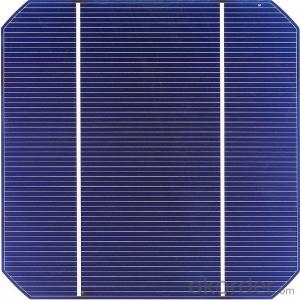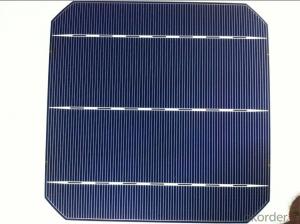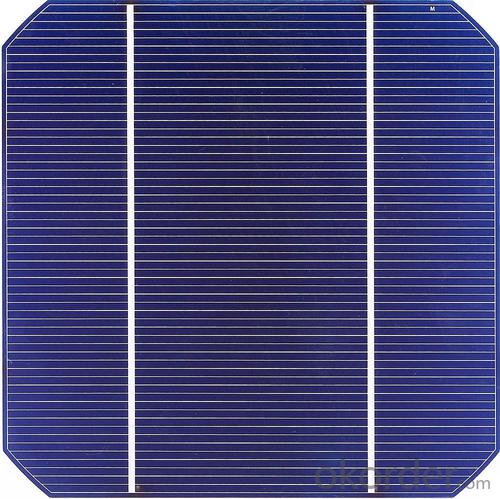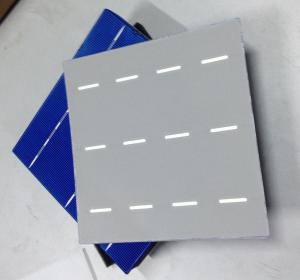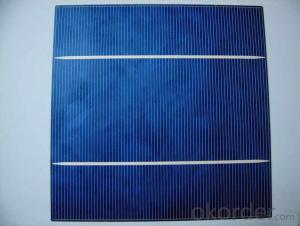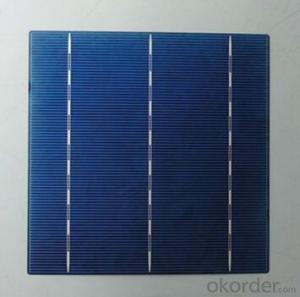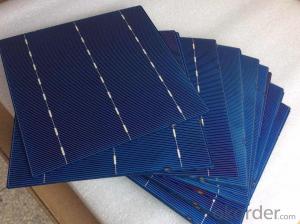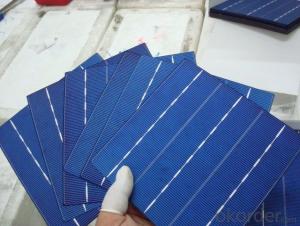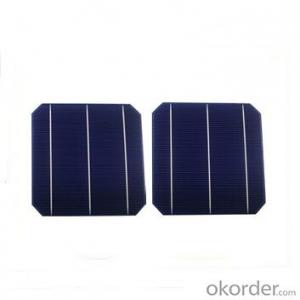Roll To Roll Monocrystalline Solar Cells - Tire 1 Manufacturer - 18% Efficiency
- Loading Port:
- Shanghai
- Payment Terms:
- TT OR LC
- Min Order Qty:
- 10000 pc
- Supply Capability:
- 50000000 pc/month
OKorder Service Pledge
OKorder Financial Service
You Might Also Like
Specifications of Mono Solar Cells
Format : 156 mm × 156 mm ± 0.5 mm
Thickness: 210 μm ±40 μm
Front (-) : 1.5mm bus bars (silver),blue anti-reflection coating (silicon nitride)
Back (+) : 2.5mm wide soldering pads (silver) back surface field (aluminium)
Electrical Characteristic of Mono Solar Cells
Efficiency (%) | Pmpp (W) | Umpp (V) | Impp (A) | Uoc (V) | Isc (A) | FF (%) |
18.35 | 4.384 | 0.526 | 8.333 | 0.63 | 8.877 | 78.39% |
18.20 | 4.349 | 0.526 | 8.263 | 0.63 | 8.789 | 78.54% |
18.05 | 4.313 | 0.525 | 8.216 | 0.63 | 8.741 | 78.32% |
17.90 | 4.277 | 0.524 | 8.161 | 0.629 | 8.713 | 78.04% |
17.75 | 4.241 | 0.523 | 8.116 | 0.629 | 8.678 | 77.70% |
17.60 | 4.206 | 0.521 | 8.073 | 0.628 | 8.657 | 77.36% |
17.45 | 4.170 | 0.519 | 8.039 | 0.628 | 8.633 | 76.92% |
17.30 | 4.134 | 0.517 | 8.004 | 0.626 | 8.622 | 76.59% |
17.15 | 4.098 | 0.516 | 7.938 | 0.625 | 8.537 | 76.80% |
17.00 | 4.062 | 0.512 | 7.933 | 0.625 | 8.531 | 76.18% |
16.75 | 4.002 | 0.511 | 7.828 | 0.625 | 8.499 | 75.34% |
16.50 | 3.943 | 0.510 | 7.731 | 0.625 | 8.484 | 74.36% |
Advantage of Polycrystalline Solar Cells
1. Tire-1 Solar Cells’ Manufacturer Quality Guarantee. With a complete and sophisticated quality government system, our Quality Management have arrived world’s leading place. Customer can receive Tire-1 Cells Maker’s Quality Standard Products.
2. Trusted Warranty. We can supply trusted after-sales service to our customer. If our cells are found not in conformity to the specification of manufacturer, or should the inspected quantity found in shortage, or should the packing found damaged, the buyer has the right to claim to the seller. The claim, if any, should be presented to seller within 30 days after cargo's arrival date to the port, together with related inspection report and photos issued and provided by a reputable independent surveyor such as SGS.
3. World’s Leading Manufacturer Equipment. We imported the newest and leading production equipment from abroad. Advanced equipment can guarantee the stable quality of cells. Auto production line can also save labor cost which will further cut our production cost.
4. Bulk supply: With the production capacity of 500MW, we can produce large quantity every month. This can satisfy most customer requirement.
Usage of Polycrystalline Solar Cells
Solar cells are often electrically connected and encapsulated as a module. Photovoltaic modules often have a sheet of glass on the front (sun up) side, allowing light to pass while protecting the semiconductor wafers from abrasion and impact due to wind-driven debris, rain, hail, etc. Solar cells are also usually connected in series in modules, creating an additive voltage. Connecting cells in parallel will yield a higher current; our solar cells have passed IEC Certification. With high and stable quality, our cells can greatly improve the performance of Solar Modules.
Applications of Polycrystalline Solar Cells
Assemblies of photovoltaic cells are used to make solar modules which generate electrical power from sunlight, as distinguished from a "solar module" or "solar panel". A solar array generates solar power using solar energy.
Packaging & Delivery of Polycrystalline Solar Cells
Carton Box Package and Deliver by air. It should be noticed that it should be avoid of water, sunshine and moist.
Factory Picture of Solar Cells
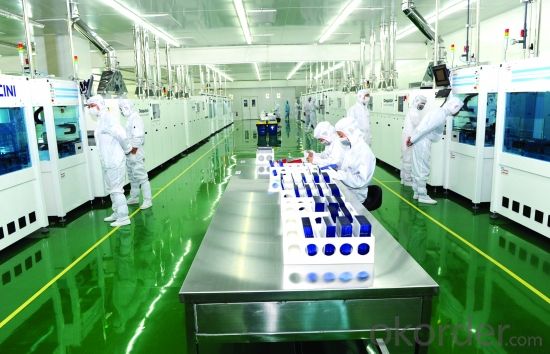
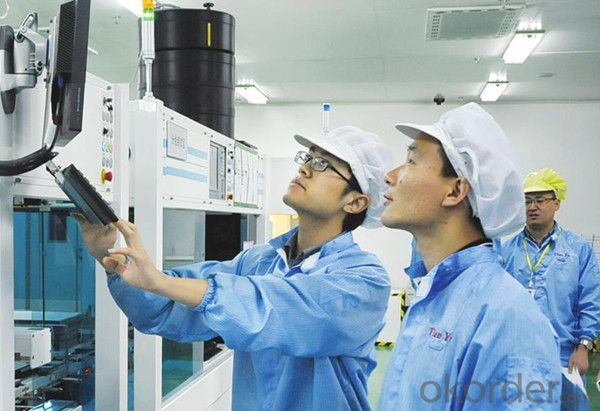
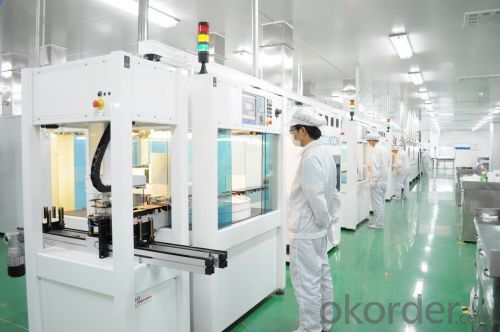
FAQ
We have organized several common questions for our clients,may help you sincerely:
1. What’s price per watt?
A: It’s depends on the quantity, delivery date and payment terms of the order. We can talk further about the detail price issue. Our products is high quality with lower price level.
2. Can you tell me the parameter of your solar cells?
We have different series of cells with different power output, both from c-si to a-si. Please take our specification sheet for your reference.
3. How do you pack your products?
We have rich experience on how to pack the panels to make sure the safety on shipment when it arrives at the destination.
4. Can you do OEM for us?
Yes, we can.
5. How long can we receive the product after purchase?
In the purchase of product within three working days, We will arrange the factory delivery as soon as possible. The perfect time of receiving is related to the state and position of customers. Commonly 7 to 10 working days can be served.
- Q: What is the role of solar cells in powering remote monitoring systems?
- Solar cells play a crucial role in powering remote monitoring systems by harnessing energy from the sun and converting it into electrical power. This ensures that these systems can operate efficiently and independently in remote locations where access to a traditional power grid may not be feasible or reliable. The solar cells collect sunlight and convert it into electricity, which is then stored in batteries or used directly to power the monitoring equipment. This sustainable and renewable energy source enables continuous operation of remote monitoring systems, making them more reliable and cost-effective in monitoring and collecting data in areas with limited or no access to conventional power sources.
- Q: What is the role of grounding systems in solar cell systems?
- The role of grounding systems in solar cell systems is to provide a safe path for electrical currents to flow, ensuring the protection of both the solar panels and the users. Grounding systems help to dissipate any excess electrical energy, preventing damage to the system and reducing the risk of electrical shocks or fires. Additionally, grounding systems aid in the proper functioning of protective devices such as fuses and circuit breakers, allowing for quick detection and isolation of electrical faults. Overall, grounding systems play a crucial role in maintaining the safety and reliability of solar cell systems.
- Q: Can solar cells be used in space heating systems?
- Yes, solar cells can be used in space heating systems. Solar thermal systems can collect and convert sunlight into heat energy, which can then be used to heat spaces. Solar panels can also be used to generate electricity, which can power electric space heaters.
- Q: Can solar cells be used in hybrid systems?
- Yes, solar cells can indeed be used in hybrid systems. Hybrid systems combine multiple sources of energy, such as solar, wind, or traditional grid power, to ensure a more reliable and efficient energy supply. Solar cells can be integrated into these hybrid systems to generate electricity from sunlight, which can be used alongside other sources to meet the energy demands of a particular system or application.
- Q: How do solar cells affect the electricity grid?
- Solar cells can have both positive and negative impacts on the electricity grid. On one hand, they can contribute to a more sustainable and renewable energy mix by generating clean electricity directly from sunlight. This reduces the need for fossil fuel-based power generation, leading to a decrease in greenhouse gas emissions and air pollution. Solar cells can also help diversify the energy sources in the grid, making it more resilient and less dependent on imported energy. On the other hand, the intermittent nature of solar power can pose challenges to the stability and reliability of the electricity grid. Since solar cells only generate electricity when the sun is shining, their output fluctuates throughout the day and is absent during nighttime. This can create imbalances between electricity supply and demand, as the grid needs to ensure a constant and reliable power supply to consumers. Additional measures, such as energy storage systems or backup power sources, may be required to address these intermittency issues and maintain grid stability. Overall, the integration of solar cells into the electricity grid presents opportunities for cleaner energy generation and reduced reliance on fossil fuels, but it also necessitates careful planning and the implementation of appropriate grid management strategies to mitigate potential challenges.
- Q: Can solar cells be used for powering electric fences?
- Yes, solar cells can be used for powering electric fences. Solar cells convert sunlight into electrical energy, which can be stored in batteries and used to power electric fences. This provides a sustainable and environmentally-friendly solution for powering fences in areas where access to grid electricity is limited or expensive.
- Q: How do solar cells perform in areas with high levels of light pollution?
- Solar cells do not perform as efficiently in areas with high levels of light pollution. The excessive artificial light can interfere with the ability of solar cells to absorb and convert sunlight into electricity. This results in reduced power output and lower overall performance of the solar cells.
- Q: How do solar cells handle fluctuating sunlight intensity?
- Solar cells are designed to handle fluctuating sunlight intensity by having built-in mechanisms that regulate the amount of energy they produce. These mechanisms include maximum power point tracking (MPPT) algorithms, which continuously monitor the incoming sunlight and adjust the voltage and current output of the solar cells to maximize their efficiency. Additionally, solar cells are also equipped with bypass diodes that help in bypassing shaded or underperforming cells, ensuring that the overall system performance is not significantly affected by fluctuating sunlight intensity.
- Q: How are solar cells used in calculators?
- Solar cells are used in calculators to convert sunlight into electrical energy. This energy is then used to power the calculator, eliminating the need for batteries or other external power sources.
- Q: Can solar cells be used on rooftops with different orientations?
- Yes, solar cells can be used on rooftops with different orientations. While solar panels typically perform best when facing south, they can still generate electricity on rooftops facing other directions. By adjusting the tilt angle and utilizing advanced tracking systems, solar cells can capture sunlight and convert it into electricity, even when the rooftop orientation is not optimal.
Send your message to us
Roll To Roll Monocrystalline Solar Cells - Tire 1 Manufacturer - 18% Efficiency
- Loading Port:
- Shanghai
- Payment Terms:
- TT OR LC
- Min Order Qty:
- 10000 pc
- Supply Capability:
- 50000000 pc/month
OKorder Service Pledge
OKorder Financial Service
Similar products
Hot products
Hot Searches
Related keywords
